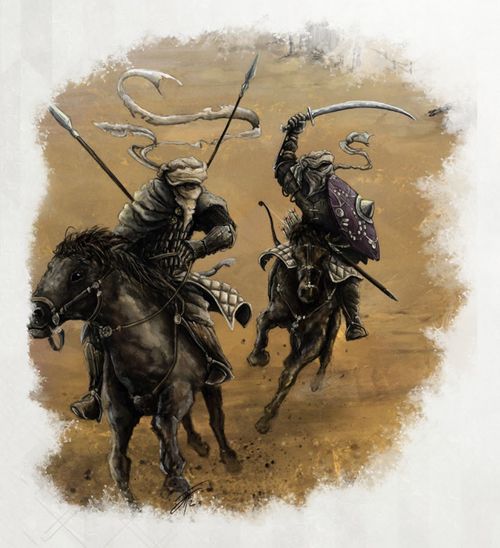Homebrew:Dragoon

(OOC: This is an implementation of the Dragoon subclass from Xanathar's Lost Notes to Everything Else)
Base Class: Fighter
Dragoons are elite combatants, selected from the ranks of standard cavalry soldiers for their prowess in battle and exceptional mounted dexterity. Their specialized training focuses as much on scouting and survival as it does advanced unit tactics, creating warriors who are just as effective on their own as with the main body of an army.
A dragoon’s effectiveness comes from seamlessly weaving a variety of weapons into mounted tactics in order to control the ebb and flow of the battlefield and halt any retreat. The refined techniques of the dragoon are typically employed in armies of humans, elves, and dwarves, but regimented goblinoid armies are known to use these cavalry tactics, as well.
Cavalry Weapons: Haft or Hilt
Issued upon the entrance to training, sabers are the typical dragoon’s weapon of choice. A cavalry weapon can be any one-handed weapon that deals bludgeoning, piercing, or slashing damage and doesn’t have the light or finesse properties. When you choose this archetype at 3rd level, your cavalry weapon deals 1d8 damage, regardless of its damage die.
Elevated Control
While cavalry traditionally refers to a mounted soldier on horseback, many armies cultivate whatever animal is best suited to the purpose in that region. While unusual, it isn’t unheard of for camels, elephants, or even giant reptiles to serve such a purpose in wartime. When you choose this archetype at 3rd level, you have advantage on Wisdom (Animal Handling Wisdom (Animal Handling)skillWhen there is any question whether you can calm down a domesticated animal, keep a mount from getting spooked, or intuit an animal’s intentions, the DM might call for a Wisdom (Animal Handling) check. You also make a Wisdom (Animal Handling) check to control your mount when you attempt a risky maneuver.) checks made to influence any beast with the capacity to be used as a mount.
Wisdom (Animal Handling)skillWhen there is any question whether you can calm down a domesticated animal, keep a mount from getting spooked, or intuit an animal’s intentions, the DM might call for a Wisdom (Animal Handling) check. You also make a Wisdom (Animal Handling) check to control your mount when you attempt a risky maneuver.) checks made to influence any beast with the capacity to be used as a mount.
Versatile Combatant
At 3rd level, you exchange the protection of heavy armor for maneuverability and precision. When you aren’t wearing heavy armor, you add double your Strength modifier to damage rolls with your cavalry weapon and your speed increases by 5 feet. When you aren’t wearing medium or heavy armor, your proficiency bonus is also doubled for attack rolls you make with your cavalry weapons, and your speed increases by an additional 5 feet, to a total of 10. While you are mounted and aren’t incapacitated, the speed of your mount also increases in this way.
Additionally, when you use the Attack action to attack with a cavalry weapon, you can use a bonus action to attack with a loaded one-handed ranged weapon you are holding. Being within 5 feet of a hostile creature doesn’t impose disadvantage on this ranged attack.
Line Breaker
At 7th level, you have learned to identify the break points in the enemy’s line and can clear the way for your allies to follow. If you move least 20 feet in a straight line, you can use your action to shove or trample enemies in your way. When you do so, each creature in your path must make a Strength saving throw with a DC equal to 8 + your proficiency bonus + your Strength modifier. On a failed save, a creature is pushed 5 feet in a direction of your choice and falls prone.
Creatures have disadvantage on this saving throw if you are mounted.
Flanking Maneuvers
At 10th level, your battlefield awareness allows you to sense a retreat and cut it off as it happens. When you hit a creature with an opportunity attack, you can move up to half your speed immediately after the attack as part of the same reaction. This movement doesn’t provoke opportunity attacks.
Starting at 18th level, if you make a melee attack against a creature, that creature can’t make an opportunity attack against you for the rest of your turn.
Strategic Stride
Starting at 15th level, moving through difficult terrain costs you, or your mount, no extra movement. You can also pass through nonmagical plants and natural terrain without being slowed by them and without taking damage from them if they have thorns, spines, or a similar hazard.
While traveling for an hour or more while mounted, you gain the following benefits:
- Difficult terrain doesn’t slow your group’s travel.
- Your group can’t become lost except by magical means.
- Even when you're engaged in another activity while traveling (such as foraging, navigating, or tracking), you remain alert to danger.
- If you are traveling alone, or with up to nine other mounted creatures, you can move stealthily at a normal pace.
- While tracking other creatures, you also learn their exact numbers, their sizes and how long ago they passed through the area.
